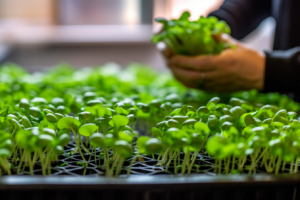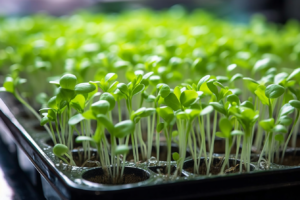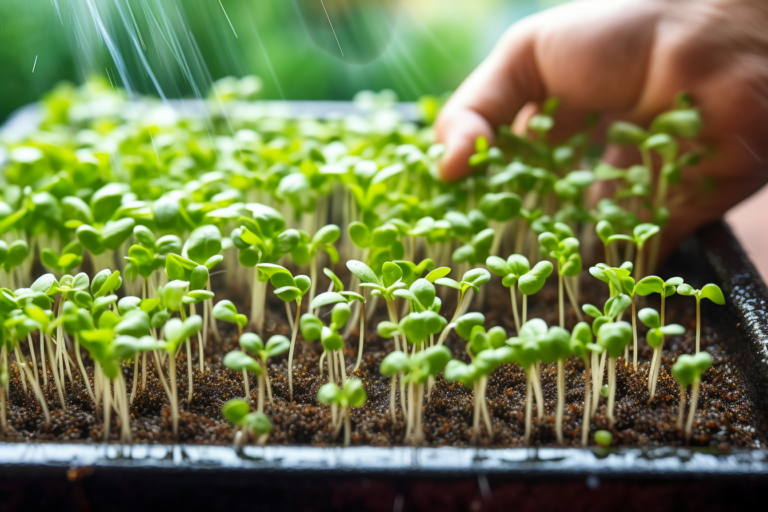Microgreens are the young, tender shoots of plants that are harvested just after the first true leaves have developed. They are packed with nutrients and flavor, making them a popular choice for chefs, home cooks, and health enthusiasts alike.
The Importance of Proper Watering
Watering microgreens is crucial to their health and overall growth. Proper watering ensures that the plants receive enough moisture to support growth, nutrient uptake, and photosynthesis. However, too much water can lead to problems like mold, root rot, and stunted growth. Conversely, too little water can cause wilting and slow growth.
Factors Affecting Watering Frequency
There is no one-size-fits-all answer to how often to water microgreens. Several factors influence the watering frequency, including:
Type of Microgreen
Different microgreen varieties have varying water requirements. For example, some microgreens like peas and sunflowers prefer more water, while others like arugula and radish can tolerate drier conditions.
Growth Stage
Microgreens have different watering needs at different stages of growth. Generally, they need more water during germination and the early growth stages. As they mature, their water requirements decrease.
Climate and Environment
The climate and growing environment play a significant role in determining how often to water microgreens. Warmer and drier environments will require more frequent watering, while cooler and more humid conditions will require less.
Growing Medium
The choice of growing medium impacts the water retention and drainage properties. Some mediums, like coconut coir and peat moss, retain water well and require less frequent watering. Others, like perlite and vermiculite, provide excellent drainage and may need more regular watering.
Container and Drainage
Containers with good drainage help prevent overwatering, while containers with poor drainage can cause water to accumulate, leading to root rot and other issues.
Methods of Watering Microgreens
There are several methods for watering microgreens, each with its advantages and disadvantages:
Top Watering
Top watering involves applying water directly to the growing medium surface. This method is simple and easy but can sometimes cause soil splashing, which may damage the delicate microgreens.
Bottom Watering
In bottom watering, water is poured into the tray underneath the growing medium, allowing the roots to absorb the moisture they need. This method minimizes soil disturbance and encourages deep root growth, but it can also lead to overwatering if not monitored carefully.
Mist Spraying
Mist spraying is another method used for watering microgreens, especially during the germination stage. A spray bottle or misting system is used to gently moisten the seeds and growing medium. This technique helps maintain consistent moisture levels without disturbing the seeds, but it requires more frequent application.
Signs of Overwatering and Underwatering
Knowing the signs of overwatering and underwatering can help you adjust your watering schedule to meet your microgreens’ needs. Here are some common symptoms:

- Overwatering: Yellowing leaves, wilted appearance, mold or fungus growth, and root rot.
- Underwatering: Dry and brittle leaves, slow growth, and wilting.
Tips for Watering Microgreens
Here are some helpful tips to ensure your microgreens receive the right amount of water:
- Always use clean, room-temperature water to prevent shocking the plants or introducing contaminants.
- Water in the morning or evening to minimize evaporation and ensure the water is absorbed effectively.
- Monitor your microgreens closely and adjust your watering schedule based on their appearance and the factors discussed above.
- Experiment with different watering methods and find the one that works best for your microgreens and growing setup.

Conclusion
In conclusion, determining how often to water microgreens depends on various factors such as the type of microgreen, growth stage, climate, growing medium, and watering method. By observing your microgreens and understanding their needs, you can create the optimal watering schedule for healthy, thriving plants.
FAQs
How often should I water microgreens during germination?
During germination, it is essential to keep the seeds consistently moist. You may need to water or mist them multiple times a day to ensure the proper moisture levels.
Can I use tap water to water my microgreens?
Yes, you can use tap water, but it's better to let it sit for a few hours to let chlorine evaporate or use a water filter to remove any potential contaminants.
Do microgreens need less water as they grow?
As microgreens mature, their water requirements generally decrease. However, it's essential to monitor their appearance and adjust watering as needed.
How can I tell if my microgreens need more water?
If your microgreens have dry, brittle leaves or show signs of wilting, they may need more water. Adjust your watering schedule accordingly.
What should I do if I accidentally overwater my microgreens?
If you overwater your microgreens, try to remove any excess water from the tray and ensure proper drainage. Monitor them closely for any signs of mold or root rot and adjust your watering schedule to prevent future overwatering.

